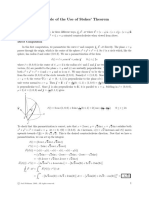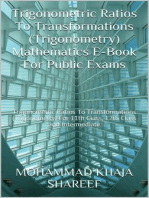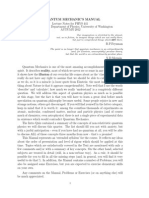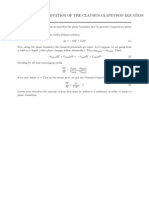16.1. Problem Set I 197 Answers: Problem Set I: Ikx Ikx M M
16.1. Problem Set I 197 Answers: Problem Set I: Ikx Ikx M M
Uploaded by
Shweta SridharCopyright:
Available Formats
16.1. Problem Set I 197 Answers: Problem Set I: Ikx Ikx M M
16.1. Problem Set I 197 Answers: Problem Set I: Ikx Ikx M M
Uploaded by
Shweta SridharOriginal Description:
Original Title
Copyright
Available Formats
Share this document
Did you find this document useful?
Is this content inappropriate?
Copyright:
Available Formats
16.1. Problem Set I 197 Answers: Problem Set I: Ikx Ikx M M
16.1. Problem Set I 197 Answers: Problem Set I: Ikx Ikx M M
Uploaded by
Shweta SridharCopyright:
Available Formats
16.1.
PROBLEM SET I 197
Answers: Problem set I
1. (a) In one dimension, the current operator is specied by
j =
1
2m
(
p +
( p)
). Applied to the left hand side of the system (outside the region
of the potential), where (x) = Ae
ikx
+Be
ikx
, we have j
left
=
k
m
(|A|
2
|B|
2
); similarly j
right
=
k
m
(|C|
2
|D|
2
). Current conservation demands
that j
left
= j
right
, i.e. |A|
2
+|D|
2
= |C|
2
+|B|
2
all of the incoming beam
is transferred to the outgoing beam, a statement of particle conservation.
This conservation of current can be written as
in
|
in
=
out
|
out
.
Therefore, using the expression for |
out
, we have
in
|
in
=
out
|
out
=
in
S
S
..
!
=I
in
,
leading to the unitarity condition.
(b) From the unitarity condition, it follows that
S
S = I =
_
|t|
2
+ |r|
2
rt
+r
t
rt
+ r
t |t|
2
+ |r|
2
_
Comparing the matrix elements, we obtained the required result.
(c) For the -function scattering problem, the wavefunction is given by
(x) =
_
e
ikx
+ re
ikx
x < 0
te
ikx
x > 0
For the -function potential, the wavefunction must remain continuous as
x = 0, and
x
|
+
x
|
=
2maV
0
2
(0) .
This translates to the conditions 1 +r = t, and ik(t 1 +r) =
2maV0
2
t.
As a result, we obtain
t =
ik
ik +
maV0
2
,
as required. Using the result from (b), since the potential is symmetric,
we have
r
2
=
t
t
(|t|
2
1) =
ik +
ik +
_
k
2
k
2
+
2
1
_
=
ik +
ik +
2
k
2
+
2
=
2
(ik +)
2
As a result, we obtain the required expression for r.
2. (a) We are told that
H|
1
= E
1
|
1
and
H|
2
= E
2
|
2
, where E
1
= E
2
.
Therefore
1
|
H|
2
=
_
1
H
2
dx =
_
1
E
2
2
dx = E
2
1
|
2
. Since
H is Hermitian, we can write
1
|
H|
2
=
_
(
H
1
)
2
dx =
_
(E
1
1
)
2
dx = E
1
|
2
= E
1
1
|
2
,
since E
1
and E
2
are real. Therefore, (E
1
E
2
)
1
|
2
= 0 and, if E
1
= E
2
then
1
|
2
= 0, i.e. |
1
and |
2
are orthogonal.
(b) If
A|
1
= |
2
and
A|
2
= |
1
, then adding them,
A(|
1
+ |
2
) =
|
1
+|
2
and subtracting,
A(|
1
|
2
) = |
2
|
1
= (|
1
|
2
).
Hence we have an eigenvector of a = +1 corresponding to a normalized
eigenvector
1
2
(|
1
+ |
2
) and an eigenvalue a = 1 corresponding to
eigenvector
1
2
(|
1
|
2
).
Advanced Quantum Physics
16.1. PROBLEM SET I 198
(c) The time-dependent Schrodinger equation is
H = E = i
t
, hence
(t) = (t = 0)e
iEt/
. Since |
1
and |
2
are eigenstates of the Hamil-
tonian
H then we can write, |(t) =
1
2
[|
1
e
iE1t/
|
2
e
iE2t/
].
P = |(t = 0)|(t)|
2
=
1
4
[
1
|
2
|][|
1
e
iE1t/
|
2
e
iE2t/
]
2
=
1
2
[1 + cos((E
1
E
2
)t/)] = cos
2
((E
1
E
2
)t/2)
3. (a) Dierentiating the left hand side of the given expression with respect to ,
one obtains
e
a
[a, a
]
. .
=1
e
a
= 1 .
Integrating, we therefore have that e
a
ae
a
= +integration constant
.
By setting = 0 we can deduce that the constant must be a yielding
the required result. Using this result, we have that
e
a
a| = e
a
ae
a
. .
=+a
|0 = ( + a)|0 = |0 .
Lastly, to obtain the normalization, we have that
| = N
2
0|e
a
| = N
2
0|
n=0
(
a)
n
n!
|
= N
2
n=0
(
)
n
n!
0| = N
2
e
||
2
!
= 1 .
i.e. N = e
||
2
/2
as required.
(b) For the harmonic oscillator, the creation and annihilation operators are
related to the phase space operators by x =
_
2m
(a + a
), and p =
i
_
m
2
(a a
). Therefore, we have
x =
_
2m
( +
), p = i
_
m
2
(
) .
Then, using the identity (x)
2
= (x x)
2
= x
2
x
2
, we have
x
2
=
2m
|(a
2
+aa
+a
a + (a
)
2
| =
2m
(1 + ( +
)
2
),
p
2
=
m
2
|(a
2
aa
a + (a
)
2
| =
2m
(1 + (
)
2
) .
As a result, we nd that x =
2m
and p =
m
2
leading to the required
expression.
(c) The equation follows simply from the denion of the operator a and the
solution may be checked by substitution.
(d) Using the time-evolution of the stationary states, |n(t) = e
iEnt/
|n(0),
where E
n
= (n + 1/2), it follows that
|(t) = e
it/2
e
||
2
/2
n
n!
e
int
|n = e
it/2
|e
it
.
Therefore, during the time-evolution, the coherent state form is preserved
but the centre of mass and momentum follow that of the classical oscilla-
tor,
x
0
(t) = Acos( +t), p
0
(t) = mAsin( +t) .
The width of the wavepacket remains constant.
Advanced Quantum Physics
16.1. PROBLEM SET I 199
4. (a) Starting with the electron Hamiltonian
H =
1
2m
( pqA)
2
, substitution of
the expression for the vector potential leads to the required result.
(b) Setting = m = = 1, we immediately obtained the required dimension-
less form of the Hamiltonian.
(c) Straightforward substitution of the dierential operators leads to the re-
quired identities. As a result, we can conrm that
[a, a
] =
2
4
([
z
, z] [z,
z
]) = 1 ,
and similarly [b, b
] = 1. In the complex coordinate representation,
H =
1
2
_
i(
z
+
z
)
i
4
(z z)
_
2
+
1
2
_
(
z
z
) +
1
4
(z + z)
_
2
= 2
z
z
+
1
8
zz +
1
2
(z
z
z
z
) = 2
_
z
+
z
4
__
z
+
z
4
_
+
1
2
= a
a +
1
2
(d) The angular momentum operator is given by ( = 1)
L
z
= (x p)
z
= i(x
y
y
x
) =
i
2
((z + z)(
z
z
) (z z)(
z
+
z
))
= 2
_
z
+
z
4
__
z
+
z
4
_
+ 2
_
z
+
z
4
__
z
+
z
4
_
= (a
a b
b) .
(e) In the coordinate representation, the condition a|0, 0 = 0 translates to the
equation
2
_
z
+
z
4
_
r|0, 0 = 0
We thus obtain the Gaussian expression for the wavefunction. Then, using
the relation |0, m =
(b
)
m
m!
|0, 0, we have
r|0, m =
1
m!
2
m/2
_
z
+
z
4
_
m
1
2
e
zz/4
=
1
22
m
m!
z
m
e
zz/4
,
as required.
(f ) If we populate the states of the lowest Landau with electrons, starting
from states of the lowest angular momentum m, the wavefunction is a
Slater determinant involving entries
m
(r
j
) = z
m
j
e
|zj|
2
/4
. Taking the
determinant, and making use of the Vandemonde determinant identity,
one obtains the required many-electron wavefunction.
5. The spin operator in the (, ) direction,
S
, can be found by forming the
scalar product of the spin operator
S with a unit vector in the (, ) direction,
(sin cos , sin sin, cos ). Therefore
=
2
_
cos e
i
sin
e
i
sin cos
_
.
We need the eigenvalues of the matrix, i.e.
2
_
cos sine
i
sine
i
cos
__
u
v
_
=
_
u
v
_
.
Eliminating u and v, we nd
2
= 1 and hence the eigenvalues of
S
are /2,
as expected. Substituting the values = 1 back into the equations relating
u and v, we can infer the ratios,
u
v
= e
i
cot(/2) and e
i
tan(/2). So, in
matrix notation, the eigenstates are
_
cos(/2)
e
i
sin(/2)
_
and
_
sin(/2)
e
i
cos(/2)
_
,
Advanced Quantum Physics
16.1. PROBLEM SET I 200
for eigenvalues +/2 and /2 respectively. The spin states in the x-direction
are obtained by setting = /2, = 0, and the spin states in the y-direction
are obtained by setting = /4 in these general formulae.
6. The four states are given by
1
=
+
(1)
+
(2),
2
=
(1)
(2),
3
=
1
2
[
+
(1)
(2)+
(1)
+
(2)], and
4
=
1
2
[
+
(1)
(2)
(1)
+
(2)], where
1
,
2
and
3
are symmetric under particle interchange and
4
is antisymmet-
ric.
Since
S
+
S
=
S
2
x
+
S
2
y
+i(
S
y
S
x
S
x
S
y
) =
S
2
S
2
z
+
S
z
,
S
2
=
S
+
S
+
S
2
z
S
z
. (16.1)
Noting that
S
z
=
S
(1)
z
+
S
(2)
z
, and likewise for
S
, and using the basic results
for the operation of the spin operators on the single particle states,
S
(1)
z
(1) =
1
2
(1),
S
(1)
(1) =
(1),
S
(1)
(1) = 0 ,
we can now calculate the eect of applying
S
2
to each state. For example
S
2
1
=
2
[2
+
(1)
+
(2) +
+
(1)
+
(2)
+
(1)
+
(2)] = 2
2
1
,
where the three terms in square brackets correspond to the three operators on
the right hand side of Eq. (16.1). Likewise
2
. Clearly
S
z
3
= 0 =
S
z
4
, so
only the
S
+
S
term need be considered. We nd
S
+
S
+
(1)
(2) =
S
+
(1)
(2) =
2
(
+
(1)
(2) +
(1)
+
(2))
2
2
3
.
Similarly
S
+
S
(1)
+
(2) =
2
2
3
so that
S
2
3
= 2
2
3
,
S
2
4
= 0 .
Thus,
1
,
2
,
3
all have eigenvalue 2
2
and hence S = 1, while
4
has S = 0.
The state is clearly an eigenstate of
S
z
with eigenvalue 0, and must therefore
be a linear combination of
3
and
4
. The S = 1 component is thus the
3
term in the wavefunction with amplitude
c
3
=
3
| =
_
2
3
+
(1)
(2) +
_
1
3
(1)
+
(2)|
_
1
2
+
(1)
(2) +
_
1
2
(1)
+
(2)
=
_
1/3 +
_
1/6
The probability of S = 1 is therefore |c
3
|
2
=
3+2
2
6
= 0.971.
7. Taking as a basis the states of the
S
z
operator, we can deduce the form of the
S
x
operator most easily from the action of the spin raising and lower operators.
Noting that, for spin S = 1,
S
|S = 1, m = [2 m(m + 1)]
1/2
|1, m 1, we
can construct the matrix elements of
S
. The latter are given by
S
+
=
2
_
_
0 1 0
0 0 1
0 0 0
_
_
,
S
=
S
+
.
Then, using the relation,
S
x
=
1
2
(
S
+
S
), we obtained the matrix elements
of the operator and corresponding eigenstates,
S
x
=
2
_
_
0 1 0
1 0 1
0 1 0
_
_
,
m
x
= 1 m
x
= 0 m
x
= 1
1
2
_
_
1
2
1
_
_
1
2
_
_
1
0
1
_
_
1
2
_
_
1
2
1
_
_
Advanced Quantum Physics
16.1. PROBLEM SET I 201
When placed in a magnetic eld, B, the molecules will acquire an energy
Bm
z
, where is the magnetic moment of the molecule, which in this case
equals twice the magnetic moment of the proton, and m
z
is the eigenvalue of
S
z
. At t = 0, the molecules enter the magnetic eld in the m
x
= 1 state, after
which their wavefunction evolves with time in the usual way, i.e.
(t) = e
iB
Szt/
(0) =
1
2
_
_
e
iBt
0 0
0 0 0
0 0 e
iBt
_
_
_
_
1
2
1
_
_
=
1
2
_
_
e
iBt
2
e
iBt
_
_
.
Thus, if Bt = (2n + 1), with n an integer, the molecules will be in a pure
m
x
= 1 state, and none will pass the second lter. The time is given by
t = L/v = L
_
m/2E, where L = 20 mm and m and E are the mass and energy
of the molecules respectively. We thus have
=
(2n + 1)
BL
_
2E
m
_
1/2
= 2.84 10
26
JT
1
and hence the proton magnetic moment is 1.42 10
26
JT
1
.
Note that the result can also be obtained by treating the problem as one of
classical precession. The couple = B = L, where L = is the angular
momentum and the angular frequency of precession. If t = (2n + 1), the
molecules have precessed into the m
x
= 1 state, and the result readily follows.
8. Substituting for the denition of the spin raising and lowering operators using
the Holstein-Primako transformation, the commutator is obtained as
1
2S
2
[
S
+
,
S
] =
_
1
a
a
2S
_
1/2
a
a + 1
..
aa
_
1
a
a
2S
_
1/2
a
_
1
a
a
2S
_
a
=
_
1
a
a
2S
_
+ a
a
_
1
a
a
2S
_
a
a +
a
aa
2S
= 1
a
a
S
.
With
S
z
= (Sa
a), we obtain the required commutation relation [
S
+
,
S
] =
2
S
z
.
M (m
1
, m
2
)
3 (1, 2)
2 (1, 1) (0, 2)
1 (1, 0) (0, 1) (1, 2)
0 (1, 1) (0, 0) (1, 1)
1 (1, 2) (0, 1) (1, 0)
2 (0, 2) (1, 1)
3 (1, 2)
9. For the case
1
= 1,
2
= 2, a table of possible ways of forming each value
of M = m
1
+ m
2
is shown right. The largest value of M is 3, so the largest
value of L must be 3. There must also be a state with M = 2 corresponding
to L = 3, but we have two states with M = 2. Therefore there must be a
state with L = 2 as well. We need two states with M = 1, one for each of the
L = 3, 2 multiplets, but we actually have three states with M = 1, so there
must be an L = 1 state as well. All of the M states are now accounted for.
M (m
1
, m
2
)
4 (3, 1)
3 (3, 0) (2, 1)
2 (3, 1) (2, 0) (1, 1)
1 (2, 1) (1, 0) (0, 1)
0 (1, 1) (0, 0) (1, 1)
1 (0, 1) (1, 0) (2, 1)
2 (1, 1) (2, 0) (3, 1)
3 (2, 1) (3, 0)
4 (3, 1)
For the case
1
= 3,
2
= 1, we can again for a table (see right). Following the
same logic as before, we see that states with L = 4, 3, 2 just account for all the
states.
To construct the states explicitly, we start by writing the L = 3 M = 3 state,
since there is only one way of forming M = 3, viz. |3, 3 = |1, 1 |2, 2. We
then operate with the lowering operator
L
, which is simply the sum of the
lowering operators for the two separate particles. Recalling that:
|, m =
_
( + 1) m(m1)|, m1 ,
we obtain
6|3, 2 =
2|1, 0 |2, 2 +
4|1, 1 |2, 1, where the rst
term on the right hand side comes from lowering the = 1 state and the
second from lowering the = 2 state. Hence |3, 2 =
_
1/3|1, 0 |2, 2 +
_
2/3|1, 1|2, 1. The state |2, 2 must be the orthogonal linear combination,
i.e. |2, 2 =
_
2/3|1, 0 |2, 2
_
1/3|1, 1 |2, 1. Further states could be
computed in the same way if required.
Advanced Quantum Physics
16.1. PROBLEM SET I 202
10. The commutation relations are given by [J
i
, J
j
] = i
ijk
J
k
.
(a) First dene the eigenstates
m
: J
z
m
= m
m
. To see if J
m
is an
eigenstate of J
z
, we need to look at J
z
J
m
, which is equal to J
J
z
[J
, J
z
]
m
. The required commutator is [J
, J
z
] = [J
x
, J
z
] i[J
y
, J
z
],
from the denition of J
. From the basic commutators given at the start,
this is [J
, J
z
] = ) iJ
y
J
x
) = J
(if treating like a number
is confusing, do this separately for J
+
and J
). Going back to J
z
J
m
,
we can now write this as J
J
z
m
+ J
m
. The rst term is just
J
m
m
, so this is (m 1)(J
m
). Thus, J
m
is an eigenstate of
J
z
, with eigenvalue (m 1). This establishes the raising and lowering
property of J
.
(b) Two electrons would have a total spin of S = 1 or 0. Adding a third spin
1/2 particle creates total spin S = 3/2 or 1/2 from the S = 1 two-particle
state. The S = 0 two-particle state becomes S = 1/2 only on adding the
third particle, so total S = 3/2 or 1/2 are the only possibilities.
(c) The states with well-dened values of m
1
, m
2
, and m
3
for the z spin
components of all particles are the uncoupled basis. Where all particles
are spin up, this state may be written as | . This state is also the
m
S
= 3/2 state of total S = 3/2 (there is no other way to get m
1
+m
2
+
m
3
= 3/2 in the uncoupled basis). We can therefore write |S = 3/2, m
S
=
3/2 = | . To get from here to |S = 3/2, m
S
= 1/2, we need to apply
J
= S
(1)
+S
(2)
+S
(3)
. In other words, the total lowering operator is the
sum of the lowering operator for each separate spin (reasonably enough)
this follows from the denition of J
and J
x
= S
(1)
x
+ S
(2)
x
+ S
(3)
x
, etc.
Now, we need to use the given normalization result. This says that
J
|S = 3/2, m
S
= 3/2 =
_
15/4 3/4|S = 3/2, m
S
= 1/2
=
3|S = 3/2, m
S
= 1/2 .
Notice that the total quantum number, J, is the same as the overall spin
quantum number, S in this case. Therefore |S = 3/2, m
S
= 1/2 =
(1/
3)J
|S = 3/2, m
S
= 3/2. Using the given normalization result
again for a single state, S
|1/2, 1/2 =
_
3/4 + 1/4|1/2, 1/2. This
establishes the required result.
Advanced Quantum Physics
You might also like
- Le Bellac M. A Short Introduction To Quantum Information and Quantum Computation.. Solutions of Exercises (Draft, 2006) (28s) - PQMDocument28 pagesLe Bellac M. A Short Introduction To Quantum Information and Quantum Computation.. Solutions of Exercises (Draft, 2006) (28s) - PQMthilin100% (1)
- SUMS Elementary Number Theory (Gareth A. Jones Josephine M. Jones) PDFDocument317 pagesSUMS Elementary Number Theory (Gareth A. Jones Josephine M. Jones) PDFtkov1100% (15)
- OU Open University SM358 2012 Exam SolutionsDocument20 pagesOU Open University SM358 2012 Exam Solutionssam smithNo ratings yet
- Solution Manual For Modern Quantum Mechanics 2nd Edition by SakuraiDocument13 pagesSolution Manual For Modern Quantum Mechanics 2nd Edition by SakuraiRyo Kinase36% (14)
- (Solutions Manual) Fourier and Laplace Transform - AntwoordenDocument87 pages(Solutions Manual) Fourier and Laplace Transform - AntwoordenSiddharth N. Meshram100% (1)
- Evolution of Firewalls: Toward Securer Network Using Next Generation FirewallDocument19 pagesEvolution of Firewalls: Toward Securer Network Using Next Generation Firewallsadaf pour1986No ratings yet
- Pulsar 150 2018Document74 pagesPulsar 150 2018Claudia Giron Klarks75% (4)
- MA1505 Tutorial Solution 1Document6 pagesMA1505 Tutorial Solution 1Bilguun BatboldNo ratings yet
- Quantum Mechanics IIDocument6 pagesQuantum Mechanics IITseliso Man100% (1)
- Sakurai Ch4 1 2 3 4 8 10 12Document12 pagesSakurai Ch4 1 2 3 4 8 10 12Fernando Da Silva BorgesNo ratings yet
- Coherent States of The Harmonic Oscillator: 1. What Is A Coherent State ?Document7 pagesCoherent States of The Harmonic Oscillator: 1. What Is A Coherent State ?ZbiggNo ratings yet
- Quantum Mechanics I Solutions 6.: HintDocument12 pagesQuantum Mechanics I Solutions 6.: HintShweta SridharNo ratings yet
- Solutions To The 62nd William Lowell Putnam Mathematical Competition Saturday, December 1, 2001Document3 pagesSolutions To The 62nd William Lowell Putnam Mathematical Competition Saturday, December 1, 2001anon020202No ratings yet
- absheheDocument14 pagesabsheheEben AsareNo ratings yet
- Qmi HW 6Document13 pagesQmi HW 6Matt BeckNo ratings yet
- Solutions To Fall 2006 Math 301 Midterm Problems: N M 1 N NDocument4 pagesSolutions To Fall 2006 Math 301 Midterm Problems: N M 1 N NJacky PoNo ratings yet
- Lognormal and Normal DistributionsDocument14 pagesLognormal and Normal DistributionsKam Fong ChanNo ratings yet
- Example of The Use of Stokes' TheoremDocument3 pagesExample of The Use of Stokes' Theoremmohamed elfekyNo ratings yet
- Antwoorden - Fourier and Laplace Transforms, Manual SolutionsDocument87 pagesAntwoorden - Fourier and Laplace Transforms, Manual SolutionsEstefanía Páez CoyNo ratings yet
- The Normal and Lognormal Distributions: John NorstadDocument14 pagesThe Normal and Lognormal Distributions: John NorstadkalichkoNo ratings yet
- STAT 330 Extra Problems - Chapters 1 To 5Document6 pagesSTAT 330 Extra Problems - Chapters 1 To 5Matt WangNo ratings yet
- Example of The Use of Stokes TheoremDocument3 pagesExample of The Use of Stokes TheoremSam FraserNo ratings yet
- Sakurai 1.17Document11 pagesSakurai 1.17uberpawsNo ratings yet
- Putnam 2009 SolutionsDocument5 pagesPutnam 2009 SolutionsWilliam MaxwellNo ratings yet
- 1Document2 pages1Kiran SaipolaNo ratings yet
- 175 Fall2009 Final SolDocument6 pages175 Fall2009 Final Solnurullah_bulutNo ratings yet
- Quantum Physics III (8.06) Spring 2008 Solution Set 10: ψ (x) = (k/a + i tanh (ax) ) eDocument7 pagesQuantum Physics III (8.06) Spring 2008 Solution Set 10: ψ (x) = (k/a + i tanh (ax) ) epac_man2No ratings yet
- m820 Sol 2011Document234 pagesm820 Sol 2011Tom DavisNo ratings yet
- Quantum Mechanics - Homework Assignment 3: Alejandro G Omez Espinosa October 8, 2012Document7 pagesQuantum Mechanics - Homework Assignment 3: Alejandro G Omez Espinosa October 8, 2012Alejandro EspinosaNo ratings yet
- Solutions To The 72nd William Lowell Putnam Mathematical Competition Saturday, December 3, 2011Document4 pagesSolutions To The 72nd William Lowell Putnam Mathematical Competition Saturday, December 3, 2011bigbigbig90003270No ratings yet
- Physics 443, Solutions To PS 5Document7 pagesPhysics 443, Solutions To PS 5Thương Thương NguyễnNo ratings yet
- Detailed Solutions A-07 JUNE 2003: I X X F F IDocument32 pagesDetailed Solutions A-07 JUNE 2003: I X X F F IAdzLinkBalaoangNo ratings yet
- 2001s PDFDocument3 pages2001s PDFSerdar BerdiyevNo ratings yet
- Optical TheoremDocument5 pagesOptical TheoremMario PetričevićNo ratings yet
- (Tang C.) Solutions Manual. Fundamentals of OrgDocument65 pages(Tang C.) Solutions Manual. Fundamentals of OrgMehdi Torabi GoodarziNo ratings yet
- Chapter 4. Harmonic Oscillator: 1 Examples of Harmonic OscillatorsDocument10 pagesChapter 4. Harmonic Oscillator: 1 Examples of Harmonic OscillatorsSidhartha SamtaniNo ratings yet
- Stat 700 HW3 Solutions, 10/9/09Document4 pagesStat 700 HW3 Solutions, 10/9/09Jhon Eduwin Maya OrozcoNo ratings yet
- hw3 SolDocument8 pageshw3 SolanthalyaNo ratings yet
- Creation and Destruction Operators and Coherent States: WKB Method For Ground State Wave FunctionDocument9 pagesCreation and Destruction Operators and Coherent States: WKB Method For Ground State Wave FunctionAnonymous 91iAPBNo ratings yet
- Solutions To Homework 5Document6 pagesSolutions To Homework 5David G. MirandaNo ratings yet
- On The Hurwitz Zeta-Function: Rocky Mountain Journal of Mathematics Volume 2, Number 1, Winter 1972Document8 pagesOn The Hurwitz Zeta-Function: Rocky Mountain Journal of Mathematics Volume 2, Number 1, Winter 1972Papy MaikaNo ratings yet
- 221B Lecture Notes: Notes On Spherical Bessel Functions 1 DefinitionsDocument5 pages221B Lecture Notes: Notes On Spherical Bessel Functions 1 DefinitionsKhem UpathambhakulNo ratings yet
- Partial Differential Equations 7.3 Hyperbolic Equations: 7.3-2 D'Alembert's MethodDocument9 pagesPartial Differential Equations 7.3 Hyperbolic Equations: 7.3-2 D'Alembert's Methodmasyuki1979No ratings yet
- Chapt 15Document39 pagesChapt 15Látex Estrada VázquezNo ratings yet
- Homework 4Document7 pagesHomework 4Alejandro Espinosa100% (1)
- Tempspin 2Document5 pagesTempspin 2Jarryd RastiNo ratings yet
- Aitchison Hay Solutions 1 PDFDocument37 pagesAitchison Hay Solutions 1 PDFJovan JovanovicNo ratings yet
- Conformal Field NotesDocument7 pagesConformal Field NotesSrivatsan BalakrishnanNo ratings yet
- Problem Set 4, Physics 622 (Fall 2001) Solutions: Ien (T T0)Document6 pagesProblem Set 4, Physics 622 (Fall 2001) Solutions: Ien (T T0)Serdar ÖztetikNo ratings yet
- 0.1 Integration: 0.1.1 Trapesoid RuleDocument3 pages0.1 Integration: 0.1.1 Trapesoid RuleMing-Chien HsuNo ratings yet
- Gaussian CurvatureDocument8 pagesGaussian CurvaturePrakash Singh RawalNo ratings yet
- Problem Set 7: Y 2 X Y X ∞ −∞ X dω 2πDocument4 pagesProblem Set 7: Y 2 X Y X ∞ −∞ X dω 2πanthalyaNo ratings yet
- Notes Ch5Document16 pagesNotes Ch5Islamic PointNo ratings yet
- Mathematics 1St First Order Linear Differential Equations 2Nd Second Order Linear Differential Equations Laplace Fourier Bessel MathematicsFrom EverandMathematics 1St First Order Linear Differential Equations 2Nd Second Order Linear Differential Equations Laplace Fourier Bessel MathematicsNo ratings yet
- Transformation of Axes (Geometry) Mathematics Question BankFrom EverandTransformation of Axes (Geometry) Mathematics Question BankRating: 3 out of 5 stars3/5 (1)
- A-level Maths Revision: Cheeky Revision ShortcutsFrom EverandA-level Maths Revision: Cheeky Revision ShortcutsRating: 3.5 out of 5 stars3.5/5 (8)
- Trigonometric Ratios to Transformations (Trigonometry) Mathematics E-Book For Public ExamsFrom EverandTrigonometric Ratios to Transformations (Trigonometry) Mathematics E-Book For Public ExamsRating: 5 out of 5 stars5/5 (1)
- Student Solutions Manual to Accompany Economic Dynamics in Discrete Time, second editionFrom EverandStudent Solutions Manual to Accompany Economic Dynamics in Discrete Time, second editionRating: 4.5 out of 5 stars4.5/5 (2)
- Analytic Geometry: Graphic Solutions Using Matlab LanguageFrom EverandAnalytic Geometry: Graphic Solutions Using Matlab LanguageNo ratings yet
- A Quantum Mechanic's ManualDocument12 pagesA Quantum Mechanic's ManualShweta SridharNo ratings yet
- Lecture 9 ABC, CVP PDFDocument58 pagesLecture 9 ABC, CVP PDFShweta SridharNo ratings yet
- Classical Mechanics Homework 11Document4 pagesClassical Mechanics Homework 11Shweta SridharNo ratings yet
- Classical Mechanics Homework 10Document2 pagesClassical Mechanics Homework 10Shweta SridharNo ratings yet
- Calculus: Fundamental TheoremDocument4 pagesCalculus: Fundamental TheoremShweta SridharNo ratings yet
- Classical Mechanics Homework 12Document2 pagesClassical Mechanics Homework 12Shweta SridharNo ratings yet
- Physics 127a: Class Notes: Lecture 17: Ideal Fermi GasDocument7 pagesPhysics 127a: Class Notes: Lecture 17: Ideal Fermi GasShweta SridharNo ratings yet
- Derivation of Clausius Clapeyron Equation PDFDocument1 pageDerivation of Clausius Clapeyron Equation PDFShweta SridharNo ratings yet
- Vector Calculus: Notes For Math1c, Spring Term 2011Document15 pagesVector Calculus: Notes For Math1c, Spring Term 2011Shweta SridharNo ratings yet
- Kabilan Internship Report A4Document19 pagesKabilan Internship Report A4harihk0312No ratings yet
- Bau Job 11Document6 pagesBau Job 11sanojk_2000No ratings yet
- Data Mining and WarehousingDocument10 pagesData Mining and WarehousingVANNo ratings yet
- Aboitiz Shipping Vs New India AssuranceDocument1 pageAboitiz Shipping Vs New India AssuranceDi ko alam100% (2)
- Computer Architecture 2 MarksDocument32 pagesComputer Architecture 2 MarksArchanavgs0% (1)
- KPI Definitions in TEMS ProductsDocument15 pagesKPI Definitions in TEMS ProductskaniNo ratings yet
- Accounting For NPO PDFDocument31 pagesAccounting For NPO PDFNicole TaylorNo ratings yet
- Eng 103 DigitalDocument50 pagesEng 103 Digitalzr8ykt8h5gNo ratings yet
- Ujian f2 1Document4 pagesUjian f2 1Ismariza IsmailNo ratings yet
- Multi Storey Building ReviewedDocument30 pagesMulti Storey Building ReviewedAbdulyekini AhmaduNo ratings yet
- Social Housing in LondonDocument5 pagesSocial Housing in Londonss44kkuurraa8888No ratings yet
- TX-nr609 Manual eDocument88 pagesTX-nr609 Manual eSrinivas Yugender TeraNo ratings yet
- Reducing The Cover-To-Diameter Ratio For Shallow Tunnels in Soft SoilsDocument177 pagesReducing The Cover-To-Diameter Ratio For Shallow Tunnels in Soft SoilsNguyễn Vũ Nam ChiếnNo ratings yet
- Neorez 600Document1 pageNeorez 600Abhineet ShrivastavaNo ratings yet
- C Compert IbmDocument35 pagesC Compert IbmPequeña Ostuncalco EditorialNo ratings yet
- Manual Irigatie OrbitDocument39 pagesManual Irigatie OrbitcatapetruNo ratings yet
- PRISM DescriptionOfToolsDocument38 pagesPRISM DescriptionOfToolsMulya Nurmansyah ArdisasmitaNo ratings yet
- HARI TNPL Company ProfileDocument19 pagesHARI TNPL Company ProfileHariKishanNo ratings yet
- Application Note AN05 - Bench Testing OBD Interfaces: Doubly Terminated!Document3 pagesApplication Note AN05 - Bench Testing OBD Interfaces: Doubly Terminated!2791957No ratings yet
- (International Series in Operations Research &Amp_ Management Science 239) Shiuh-Nan Hwang, Hsuan-Shih Lee, Joe Zhu (Eds.)-Handbook of Operations Analytics Using Data Envelopment Analysis-Springer USDocument511 pages(International Series in Operations Research &Amp_ Management Science 239) Shiuh-Nan Hwang, Hsuan-Shih Lee, Joe Zhu (Eds.)-Handbook of Operations Analytics Using Data Envelopment Analysis-Springer USangọc_56100% (1)
- Mee BookDocument165 pagesMee Bookddewashish23No ratings yet
- Rohan Text Editor 14Document15 pagesRohan Text Editor 14Rathod ManthanNo ratings yet
- Workforce FocusDocument3 pagesWorkforce FocusLyerey Jed MartinNo ratings yet
- Scope of Work For Gobustone Block WorkDocument4 pagesScope of Work For Gobustone Block WorkЭльвин МамедовNo ratings yet
- 0218-Multilingual-BugManagement Defect Handling Procedures and SpecificationsDocument6 pages0218-Multilingual-BugManagement Defect Handling Procedures and SpecificationsThành LongNo ratings yet
- Kadapa District Industries Profile MSMEDocument20 pagesKadapa District Industries Profile MSMEsamsarmaNo ratings yet
- Karnataka Tourism Statistics.Document128 pagesKarnataka Tourism Statistics.jangegNo ratings yet
- 665report - Design of CMOS Ring VCO and Quadrature LC VCO For 8 Phases GenerationDocument17 pages665report - Design of CMOS Ring VCO and Quadrature LC VCO For 8 Phases GenerationapplebeeNo ratings yet



































































































